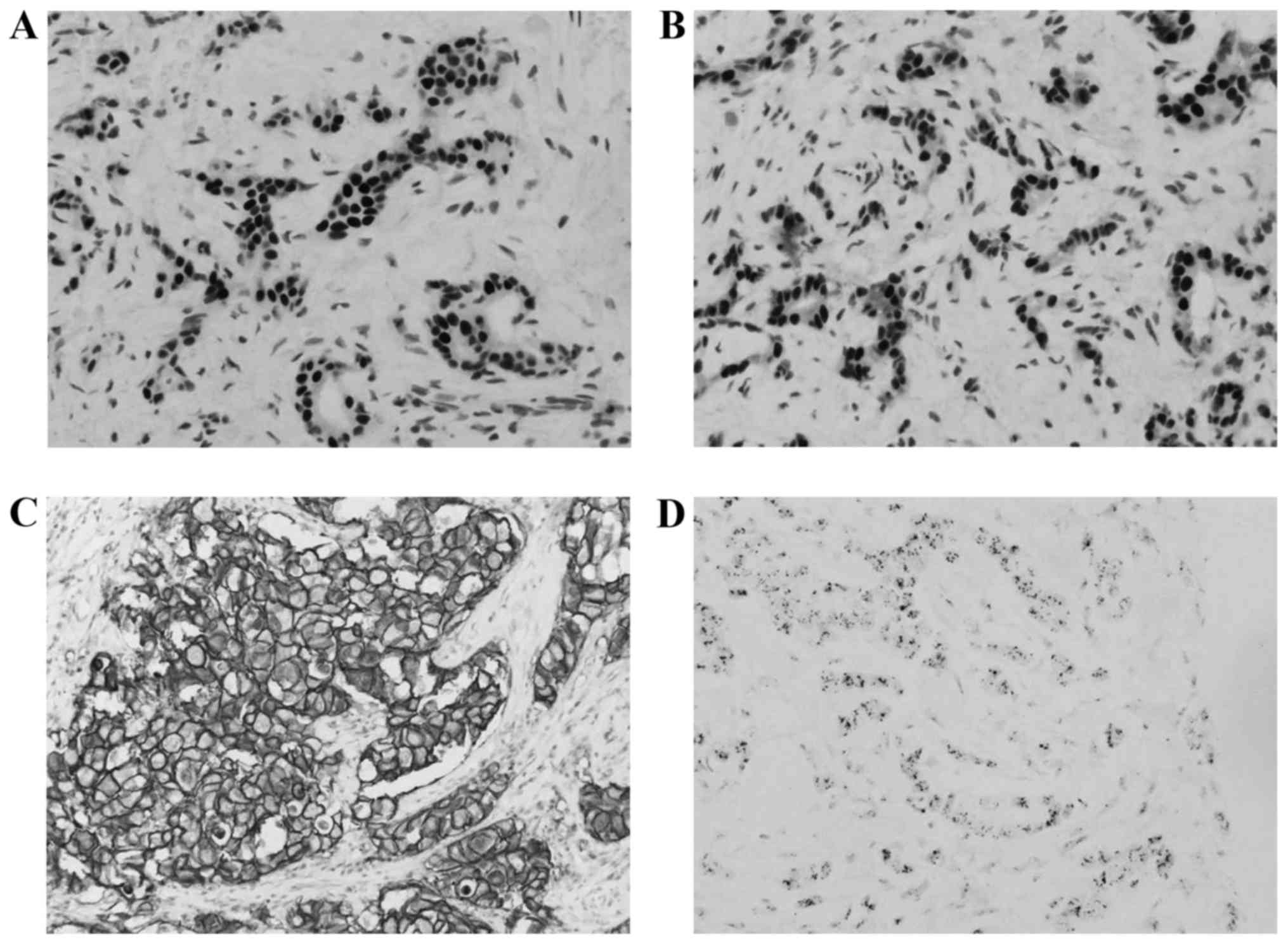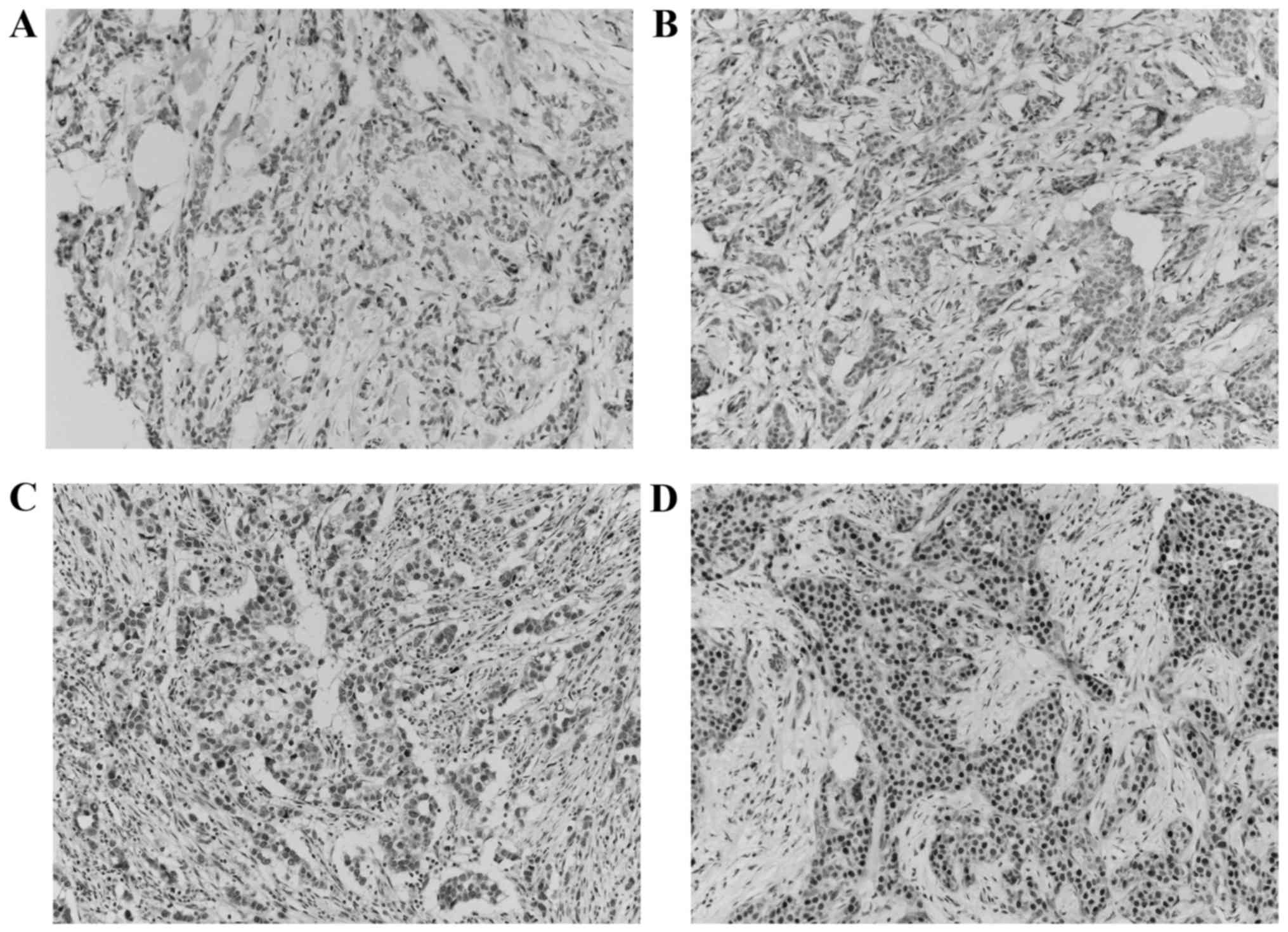|
1
|
Li CI, Anderson BO, Daling JR and Moe RE:
Trends in incidence rates of invasive lobular and ductal breast
carcinoma. JAMA. 289:1421–1424. 2003. View Article : Google Scholar : PubMed/NCBI
|
|
2
|
Li CI, Uribe DJ and Daling JR: Clinical
characteristics of different histologic types of breast cancer. Br
J Cancer. 93:1046–1052. 2005. View Article : Google Scholar : PubMed/NCBI
|
|
3
|
Subramaniam S, Bhoo-Pathy N, Taib NA, Tan
GH, See MH, Jamaris S, Ho GF, Looi LM and Yip CH: Breast cancer
outcomes as defined by the estrogen receptor, progesterone receptor
and human growth factor receptor-2 in a multi-ethnic Asian country.
World J Surg. 39:2450–2458. 2015. View Article : Google Scholar : PubMed/NCBI
|
|
4
|
Perou CM, Sorlie T, Eisen MB, van de Rijn
M, Jeffrey SS, Rees CA, Pollack JR, Ross DT, Johnsen H, Akslen LA,
et al: Molecular portraits of human breast tumours. Nature.
406:747–752. 2000. View
Article : Google Scholar : PubMed/NCBI
|
|
5
|
Schnitt SJ: Classification and prognosis
of invasive breast cancer: From morphology to molecular taxonomy.
Mod Pathol. 23:(Suppl 2). S60–S64. 2010. View Article : Google Scholar : PubMed/NCBI
|
|
6
|
Engstrom MJ, Opdahl S, Hagen AI,
Romundstad PR, Akslen LA, Haugen OA, Vatten LJ and Bofin AM:
Molecular subtypes, histopathological grade and survival in a
historic cohort of breast cancer patients. Breast Cancer Res Treat.
140:463–473. 2013. View Article : Google Scholar : PubMed/NCBI
|
|
7
|
Parise CA and Caggiano V: Breast Cancer
Survival Defined by the ER/PR/HER2 Subtypes and a Surrogate
Classification according to Tumor Grade and Immunohistochemical
Biomarkers. J Cancer Epidemiol. 2014:4692512014. View Article : Google Scholar : PubMed/NCBI
|
|
8
|
Gajria D and Chandarlapaty S:
HER2-amplified breast cancer: Mechanisms of trastuzumab resistance
and novel targeted therapies. Expert Rev Anticancer Ther.
11:263–275. 2011. View Article : Google Scholar : PubMed/NCBI
|
|
9
|
Hudis CA and Gianni L: Triple-negative
breast cancer: An unmet medical need. Oncologist. 16:(Suppl 1).
S1–S11. 2011. View Article : Google Scholar
|
|
10
|
Kirschner K and Melton DW: Multiple roles
of the ERCC1-XPF endonuclease in DNA repair and resistance to
anticancer drugs. Anticancer Res. 30:3223–3232. 2010.PubMed/NCBI
|
|
11
|
McNeil EM and Melton DW: DNA repair
endonuclease ERCC1-XPF as a novel therapeutic target to overcome
chemoresistance in cancer therapy. Nucleic Acids Res.
40:9990–10004. 2012. View Article : Google Scholar : PubMed/NCBI
|
|
12
|
Sidoni A, Cartaginese F, Colozza M, Gori S
and Crinó L: ERCC1 expression in triple negative breast carcinoma:
The paradox revisited. Breast Cancer Res Treat. 111:569–570. 2008.
View Article : Google Scholar : PubMed/NCBI
|
|
13
|
Ozkan C, Gumuskaya B, Yaman S, Aksoy S,
Guler G and Altundag K: ERCC1 expression in triple negative breast
cancer. J BUON. 17:271–276. 2012.PubMed/NCBI
|
|
14
|
Goyal S, Parikh RR, Green C, Schiff D,
Moran MS, Yang Q and Haffty BG: Clinicopathologic significance of
excision repair cross-complementation 1 expression in patients
treated with breast-conserving surgery and radiation therapy. Int J
Radiat Oncol Biol Phys. 76:679–684. 2010. View Article : Google Scholar : PubMed/NCBI
|
|
15
|
Gerhard R, Carvalho A, Carneiro V, Bento
RS, Uemura G, Gomes M, Albergaria A and Schmitt F:
Clinicopathological significance of ERCC1 expression in breast
cancer. Pathol Res Pract. 209:331–336. 2013. View Article : Google Scholar : PubMed/NCBI
|
|
16
|
Kim D, Jung W and Koo JS: The expression
of ERCC1, RRM1, and BRCA1 in breast cancer according to the
immunohistochemical phenotypes. J Korean Med Sci. 26:352–359. 2011.
View Article : Google Scholar : PubMed/NCBI
|
|
17
|
Edge SB: American Joint Committee On
Cancer, AJCC Cancer Staging Manual. 8th. Springer; New York, NY:
2010
|
|
18
|
O'Malley FP and Pinder SE: Breast
pathology, Churchill Livingstone. Elsevier; Edinburgh: 2006,
View Article : Google Scholar
|
|
19
|
Nadji M, Gomez-Fernandez C, Ganjei-Azar P
and Morales AR: Immunohistochemistry of estrogen and progesterone
receptors reconsidered: Experience with 5,993 breast cancers. Am J
Clin Pathol. 123:21–27. 2005. View Article : Google Scholar : PubMed/NCBI
|
|
20
|
Wolff AC, Hammond ME, Hicks DG, Dowsett M,
McShane LM, Allison KH, Allred DC, Bartlett JM, Bilous M,
Fitzgibbons P, et al: Recommendations for human epidermal growth
factor receptor 2 testing in breast cancer: American Society of
Clinical Oncology/College of American Pathologists clinical
practice guideline update. J Clin Oncol. 31:3997–4013. 2013.
View Article : Google Scholar : PubMed/NCBI
|
|
21
|
Remmele W and Stegner HE: Recommendation
for uniform definition of an immunoreactive score (IRS) for
immunohistochemical estrogen receptor detection (ER-ICA) in breast
cancer tissue. Pathologe. 8:138–140. 1987.(In German). PubMed/NCBI
|
|
22
|
Kelland L: The resurgence of
platinum-based cancer chemotherapy. Nat Rev Cancer. 7:573–584.
2007. View
Article : Google Scholar : PubMed/NCBI
|
|
23
|
Fu JM, Zhou J, Xie JS and Li H: Effect of
neoadjuvant chemotherapy on ERCC1 gene expression in breast cancer.
Nan Fang Yi Ke Da Xue Xue Bao. 28:603–605. 2008.(In Chinese).
PubMed/NCBI
|
|
24
|
Metro G, Zheng Z, Fabi A, Schell M,
Antoniani B, Mottolese M, Monteiro AN, Vici P, Lara Rivera S,
Boulware D, et al: In situ protein expression of RRM1, ERCC1, and
BRCA1 in metastatic breast cancer patients treated with
gemcitabine-based chemotherapy. Cancer Invest. 28:172–180. 2010.
View Article : Google Scholar : PubMed/NCBI
|
|
25
|
Lee KH, Min HS, Han SW, Oh DY, Lee SH, Kim
DW, Im SA, Chung DH, Kim YT, Kim TY, et al: ERCC1 expression by
immunohistochemistry and EGFR mutations in resected non-small cell
lung cancer. Lung Cancer. 60:401–407. 2008. View Article : Google Scholar : PubMed/NCBI
|
|
26
|
Seyhan EC, Altin S, Cetinkaya E, Sökücü S,
Abali H, Buyukpinarbasili N and Fener N: Prognostic significance of
ERCC1 expression in resected non small cell lung carcinoma. Ann
Thorac Cardiovasc Surg. 17:110–117. 2011. View Article : Google Scholar : PubMed/NCBI
|
|
27
|
Wang J, Zhou XQ, Li JY, Cheng JF, Zeng XN,
Li X and Liu P: Prognostic significance of ERCC1 expression in
postoperative patients with gastric cancer. Chin J Cancer Res.
26:323–330. 2014.PubMed/NCBI
|
|
28
|
Han W, Kim KY, Yang SJ, Noh DY, Kang D and
Kwack K: SNP-SNP interactions between DNA repair genes were
associated with breast cancer risk in a Korean population. Cancer.
118:594–602. 2012. View Article : Google Scholar : PubMed/NCBI
|
|
29
|
Mojgan H, Massoud H and Ahmad E: ERCC1
intron 1 was associated with breast cancer risk. Arch Med Sci.
8:655–658. 2012. View Article : Google Scholar : PubMed/NCBI
|
|
30
|
Mo J, Xia Y, Ning Z, Wade TJ and Mumford
JL: Elevated ERCC1 gene expression in blood cells associated with
exposure to arsenic from drinking water in Inner Mongolia.
Anticancer Res. 29:3253–3259. 2009.PubMed/NCBI
|
















